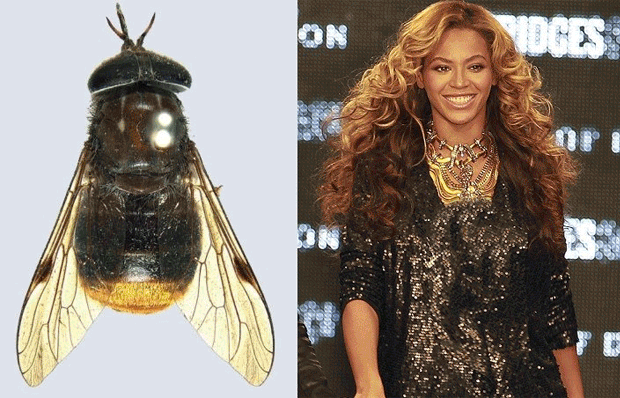|
Taxonomy is the foundation stone of science and the
system we use to categorise our complex natural world. Around one
million insect species have been named and described to date.
But there are an estimated 8-10 million living insect species on Earth,
meaning new species are being discovered on a daily basis.
Scientists who study insects, called entomologists, are coming up with
ever more imaginative names, referencing everything from musicians to
childish jokes, to meet the demand.
|
 |
Early humans needed to name the things around them so they knew what was
dangerous and inedible. This expertise is a fundamental process of the
human brain and arguably how we have survived as a species.
It wasn't until the 18th century when the Swedish botanist Carl Linnaeus
created the binomial system of nomenclature that we use today. The
official start date for modern entomological taxonomy is based on
Linnaeus' tenth edition of his work Systema Naturae published in 1758.
Linnaeus' hierarchical system means that species can be identified in
around six steps, from kingdom right down to species.
The majority of insect names refer to their appearance, behaviour or the
place in which they are found. As you'd expect Titanus giganteus is a
large beetle and a species with the name hawaiiensis is predictably
found on Hawaii.
|
 |
It is seen as pretty egotistical for an entomologist to name an insect
after themselves, but having a species named after you by someone else
is regarded as an honour. The name has the potential to live on after
the person it is named after, and perhaps even long after the species
itself becomes extinct.
Historical roll
Some names are chosen to educate a younger audience on the joys of
taxonomy. For example, in 2012 Bryan Lessard from the Australian
National Insect Collection in Canberra named a rare Australian horse fly
with a bright golden behind Scaptia beyonceae after the singer Beyoncé.
More often than not, insects with the jazziest names are small and
nondescript. American entomologist Quentin Wheeler received a phone call
from the US President after he named a trio of beetles Agathidium bushi,
Agathidium cheneyi and Agathidium rumsfeldi in a 2005 report.
Many of his colleagues believed it was a jab at the Bush administration,
but Quentin and his co-author Kelly B Miller are both Republicans and
say they named the beetles in honour of the President, the
Vice-President and the Defence Secretary.
|
 |
But as Max Barclay the curator of beetles and true bugs at the Natural
History Museum points out: "It is grossly unwise to name things after
politicians because you don't know what they're going to do and the name
is going to last forever, and your name is going to be associated with
that name forever."
One of the most infamous examples of this is a tiny blind orange beetle
called Anophthalmus hitleri. Found in only a few caves in Slovenia, it
was named in honour of the Nazi leader in 1936 by Oscar Scheibel.
Some of the more inoffensive names are best when read out loud. In 1904
British entomologist George Willis Kirkaldy gave a series of true bugs
the suffix -chisme, meaning "news" but pronounced "kiss me". Starting
with polychisme (Polly kiss me), he went on to name dolichisme (Dolly
kiss me), ochisme (Oh kiss me), and many more, seemingly after his
romantic conquests. Kirkaldy was post-humorously criticised for
frivolity by the London Zoological Society in 1912.
Senior entomologist at the Bishop Museum in Hawaii, Neal Evenhuis,
carried on Kirkaldy's work in 2002 by naming a fossil fly Carmenelectra
shechisme after the actress, Carmen Electra.
|
|
 |
He's also behind other funny names including Pieza rhea (Pizzeria),
Pieza pi (Pizza Pie), Pieza kake (Piece of cake) and not forgetting
Pieza deresistans (Pièce de résistance).
Set in stone
Scientific names are hard to change once decided upon. There are no
strict rules on who or what you can name your insect discoveries after,
but rather a series of recommendations laid out by the International
Commission on Zoological Nomenclature. The ICZN are currently working
together with scientists from all around the world to create a
comprehensive online record of every living species on earth called
ZooBank.
Common names can be equally important in educating the general public
with generic names like leaf insects performing similar descriptive
functions to scientific ones. However, problems can arise when many
insects are grouped under one common name as London Zoo found out when
the species of hissing cockroaches they were working to conserve, turned
out to be the wrong one.
The error came to light when the Natural History Museum in London
carefully inspected the species and discovered the Zoo had
Gromphadorhina oblongonata rather than Gromphadorhina portentosa.
In the past, problems with identifying species have arisen from a lack
of technology. Nowadays new molecular techniques using DNA sequencing
help scientists to look at more than just the physiological aspects of
the insect to determine species.
|
Institutions like the Oxford Museum for Natural History are working to
get the next generation involved in taxonomy. "Children love complicated
scientific names", says Rachel Parle, Education Officer at the Museum.
"With dinosaurs for example, every child will know a triceratops, a
Tyrannosaurus rex, so if they can apply them to learn the equivalent for
their favourite bug or an exciting interesting insect that they've just
discovered, then all the better."
"Taxonomy is as important now as it ever was," agrees entomology PhD
student Jen Banfield-Zanin. She argues that the general public don't see
what goes on behind the scenes and that knowing exactly which insects we
are dealing with is vitally important.
Identifying specific insects in a particular place means taxonomists can
tell what effect climatic fluctuations are having on the habitat.
The hope is that we can name all insect species before they become
extinct, but in reality the majority of species on earth will become
extinct before we even know they are there. |